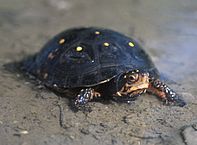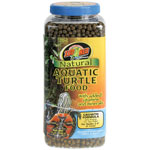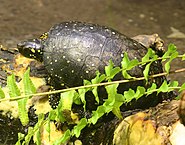The Spotted Turtle measures only 4-5 inches when fully grown, and is brightly-colored, alert, friendly and hardy…small wonder it is esteemed by turtle keepers worldwide. Although the days when I could count on finding several each summer are long gone (it is now rare in the wild), captive-bred individuals are readily available – if quite expensive! But those who give this endearing little turtle a place in their collections become instant fans, and never regret the price they paid. Shallow water specialists, Spotted Turtles are infinitely easier to care for, and require far less space, than do Sliders, Painted Turtles or any of the other more commonly-kept semi-aquatic species.
Range
The Spotted Turtle inhabits a large area of North America, but it is unevenly-distributed, and nowhere to be found in abundance. Its range extends from southern Ontario and Quebec south along the Atlantic Coastal Plain to central Florida and west through Pennsylvania to northern Indiana and northeastern Illinois.
Habitat
This unique turtle is a true habitat specialist, being restricted to the shallow, thickly-vegetated waters of bogs, swamps, sloughs and other marshy wetlands. Hatchlings are highly aquatic, but adults spend some time in moist fields and woodlands. Over-collection and habitat loss have decimated populations, which are now protected; please be sure to purchase only captive-bred individuals.
Description
The bright to light yellow spots that mark the black carapace render the Spotted Turtle nearly invisible among duckweed, yet startlingly conspicuous in an aquarium. Among the world’s smallest turtles, adults measure a mere 4-5 inches in length.
Housing
Spotted Turtles are small but quite active, always foraging and exploring their environment. They should be provided with as much room as possible. A well-designed 20 gallon long-style aquarium is adequate for a single adult, but additional room is always appreciated.
The water in the aquarium should be of a depth that allows the turtle to reach the surface with its head without needing to swim. Floating plastic or live plants should be provided as cover for the always-shy hatchlings (they are on the menus of predators ranging from giant water bugs to bullfrogs, and naturally-wary!). Adults become quite bold, but still prefer aquariums with cover, driftwood, and caves to bare enclosures.
The aquarium should be equipped with a dry basking site, UVB bulb, heater, and powerful filtration. A water temperature range of 68-76 F, with a basking site of 88-90 F, is ideal.
Wild Spotted Turtles feed upon fish, tadpoles, snails, carrion, insects, crayfish, shrimp, salamanders, frogs and aquatic plants. Pets should be offered a diet comprised largely of whole animals such as minnows, shiners, earthworms, snails, crayfish, and prawn. Some adults will also accept dandelion, zucchini, collard greens, apples and other produce. Roaches, crickets and other insects may also be provided. A high quality commercial turtle chow can comprise up to 60% of the diet.
Spinach and various cabbages may cause nutritional disorders. Goldfishes should be used sparingly, if at all, as a steady goldfish diet has been linked to kidney and liver disorders in other species.
A cuttlebone should be available to supplement the calcium provided by whole fishes and similar foods.
Feeding Note
Turtles are messy feeders, and quickly foul even well-filtered aquariums. Removing your pet to a plastic storage container at feeding time will lessen the filter’s workload and help to maintain good water quality. Partial water changes (i.e. 50 % weekly) are also very useful. Filters designed specifically for turtles, if serviced regularly, are usually preferable to those marketed for use with tropical fish. Some folks find it easier to maintain their aquatic turtles in plastic storage containers that can easily be emptied and rinsed.
Temperament
Spotted Turtles are as hardy and responsive as the more commonly-kept sliders, and are now being regularly bred by hobbyists. Although somewhat shy at first, most soon learn to rush over for food when approached. Spotted Turtles must be watched carefully if housed in groups. Males often harass females with mating attempts, and may stress or bite them in the process. Males should not be kept together, as they will usually fight.
Breeding
Mating and egg deposition occurs from April-August. Breeding behavior may be stimulated by a winter resting period at reduced temperatures, but this should not be attempted without expert guidance (please post below for further information).
Females produce 1-2 clutches of 1-8 eggs. Gravid (egg-bearing) females usually become restless and may refuse food. They should be removed to a large container (i.e. 5x the length and width of the turtle) provisioned with 6-8 inches of slightly moist soil and sand. The eggs may be incubated in moist vermiculite at 82-84 F for 50-85 days.
Gravid females that do not nest should be seen by a veterinarian as egg retention invariably leads to a fatal infection known as egg peritonitis. It is important to note that females may develop eggs even if unmated, and that captives may produce several clutches each year.
Useful Spotted Turtle Care Products (please post below for further information)
Hi, my name is Frank Indiviglio. I’m a herpetologist, zoologist, and book author, recently retired from a career spent at several zoos, aquariums, and museums, including over 20 years with the Bronx Zoo.
Please check out my posts on Twitter and Facebook. Each day, I highlight breaking research, conservation news and interesting stories concerning just about every type of animal imaginable. I look forward to hearing about your interests and experiences as well, and will use them in articles when possible.
Please also post your questions and comments below…I’ll be sure to respond quickly. Thanks, until next time, Frank.
Further Reading
 That Reptile Blog – Reptile, Amphibian and Exotic Pet Care and Information
That Reptile Blog – Reptile, Amphibian and Exotic Pet Care and Information







This is one of my favorite turtles. I have two that live iny koi fish pond. This is the second year they have been here. I was excited when they showed up. They love koi food. I did begin targeting them with some turtle food because I was worried about nutrition. Another great article!
Interesting..they are rare in many places. They’ll likely get plenty of insects there, be sure to provide some small whole fishes if they stay all season, enjoy, Frank